We hadn’t even finished unloading the car when Hal called to me from our patio area. “There’s a cheetah at the waterhole!” What? We’d only just arrived at the Kalahari Tented Camp and already there was a predator outside our door. We left our bags in the car and dug out our cameras and binoculars.
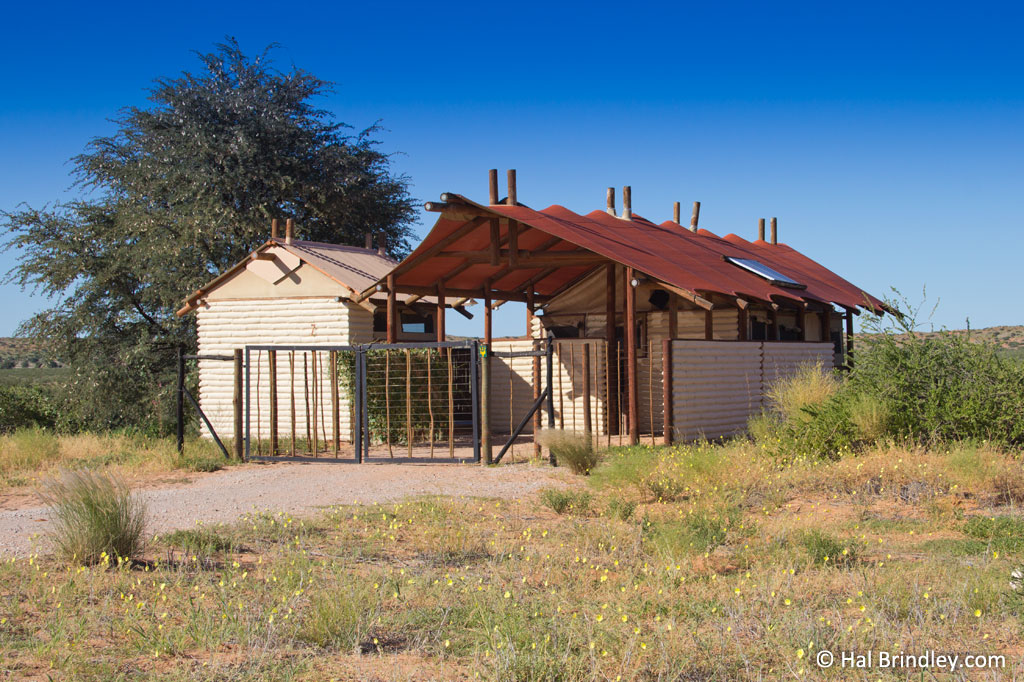
There he was, a lone cheetah drinking in the waterhole outside our window while a wildebeest looked on. I wondered who else we might see that evening if our very first animal was a cheetah, the sixth biggest cat in the world!

The Kalahari Tented camp is located a few miles east of the Namibian border in the Kgalagadi Transfontier Park of South Africa. It is perched on top of a dune and overlooks a waterhole in the dry Auob riverbed. Unlike the three main rest camps in the park, the Tented Camp is unfenced, so walking around at night is highly discouraged. Large predators, including lions, could be strolling through at any time.
That’s one of the main reasons I wanted to stay at the Kalahari Tented Camp. I had heard there was a spotted hyena that lived near the camp and was a regular visitor. So theoretically I could step out of our tent and bump into a hyena.
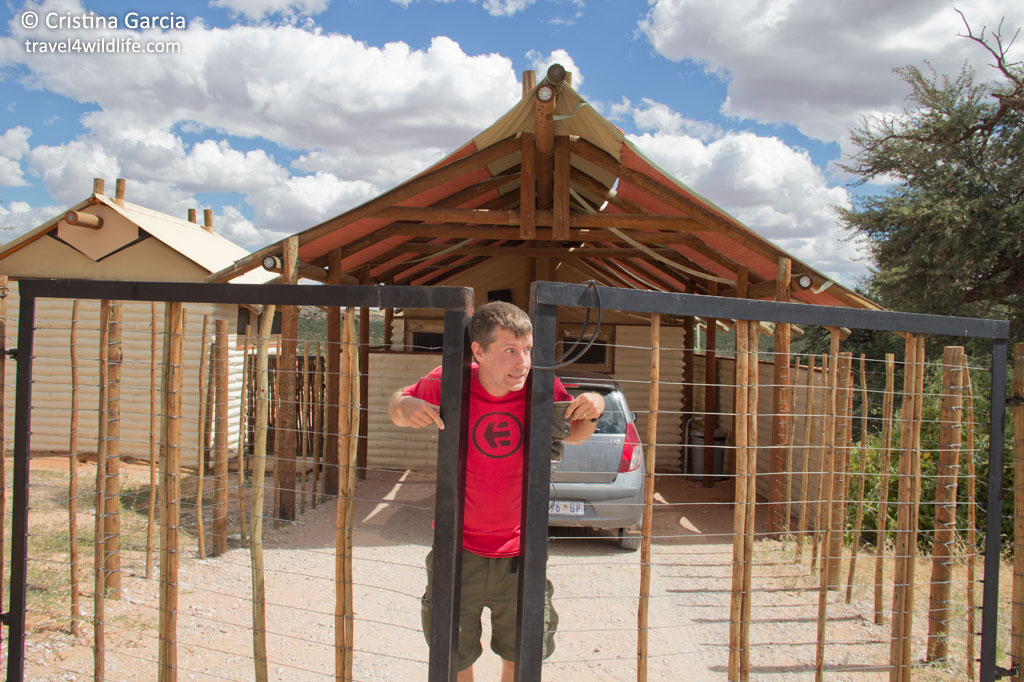
“Is the hyena around?” I asked the camp manager upon our arrival, realizing I was lumping myself into the “another-stupid-tourist” category.
“I haven’t seen her in a few days.” He sighed and looked away as he guided us to our tent, the last one in the row.
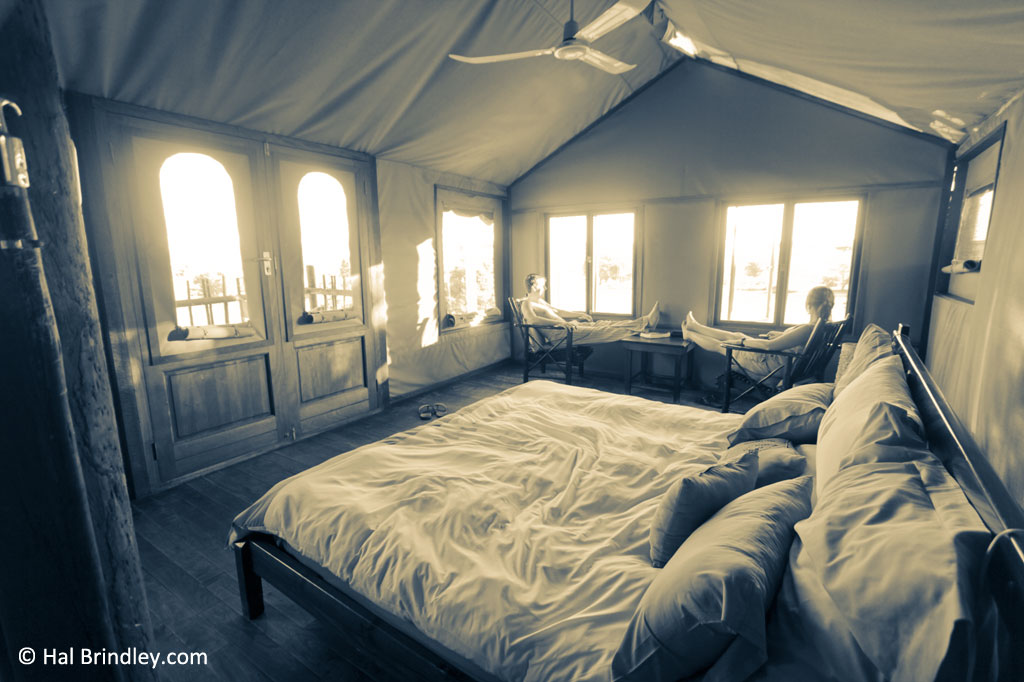
It’s called the Honeymoon Desert Tent and it’s only slightly more expensive than the regular ones, but you get a huge bed, a spacious bathroom, and uninterrupted wilderness views of the riverbed and the night sky. Though the bathroom has both a shower and a bathtub, we would like to discourage you from taking a bath. This is a semi-desert after all and water is always scarce.

The honeymoon tent is not the closest to the waterhole (even thought you can see it from your window) but because it is the last tent in the camp you have more privacy, better views, and less light to interfere with the Kalahari night sky.

One of the other tents is accessible for the mobility challenged and at least three tents (called Family Desert Tents) are suitable for families, with a bunk bed and two single beds. These other rooms have showers but no bathtubs. They all have outdoor kitchens, a wooden deck, a gravel braai area, and gas and solar energy.
There are no shops at the camp but if you need food, ice or gas, Mata Mata Rest Camp (less than 2 miles away) is the place to go. What the Tented Camp does have is a swimming pool, which is perfect for those hot summer days, as long as you don’t mind swimming in creepy green water.
All the pools at the Kgalagadi rest camps have the same greenish hue. Hal calls them “hippo pools” as they remind him of the hippo pools in zoos. I decided it wasn’t that hot.
Back in our room, we sat on our deck with a hard cider and stared at the Auob Valley searching for wildlife.

There was a giraffe in the distance, the wildebeest was still grazing near the waterhole and a yellow mongoose was busy digging underneath our tent.
There was a giraffe in the distance, the wildebeest was still grazing near the waterhole and a yellow mongoose was busy digging underneath our tent.
We cooked dinner in our outdoor kitchen and enjoyed the sunset while my favorite sound began to fill the air: the DIK DIK DIK of barking geckos. Hal set up his camera to shoot a timelapse of the starry Kalahari night sky.
Guests at the Kalahari Tented Camp are allowed to join in on the Mata Mata guided night drives. Simply inform the Tented Camp manager, arrange your payment, and the driver will stop in to pick you up on the way into the park. We were spending only one night so we decided to stay in and see who we could spot around camp. Plus we don’t usually have as much luck on the Mata Mata night drives as we do around Twee Rivieren or Nossob.
We didn’t manage to see a hyena or hear the roar of a lion that night, but the barking geckos were all I needed. To me it is the sound of the Kalahari and when I hear it I know I am where I am supposed to be.
Do you want to stay here during your visit to the Kgalagadi? You can book your tent at the Kgalagadi Transfontier Park page here.
If you enjoyed our Spotting Cheetahs at the Kalahari Tented Camp you may also like:
- VIDEO: Caracal Kittens in the Kgalagadi
- Sleeping With Bats in Twee Rivieren, Kgalagadi
- PHOTO: Honey Badger in the Central Kalahari, Botswana
- VIDEO: A Cheetah Stole my Camera
- Kalahari Anib Lodge, Namibia

Cristina Garcia
Zoologist and wildlife photographer. She has worked in the field with jackals, wolves, cheetahs, & leopards. She serves on the Board of Directors of SEE Turtles, a non-profit sea turtle conservation organization.
Read her posts at Travel For Wildlife and see more of her work at Truly Wild, & Our Wild Yard.

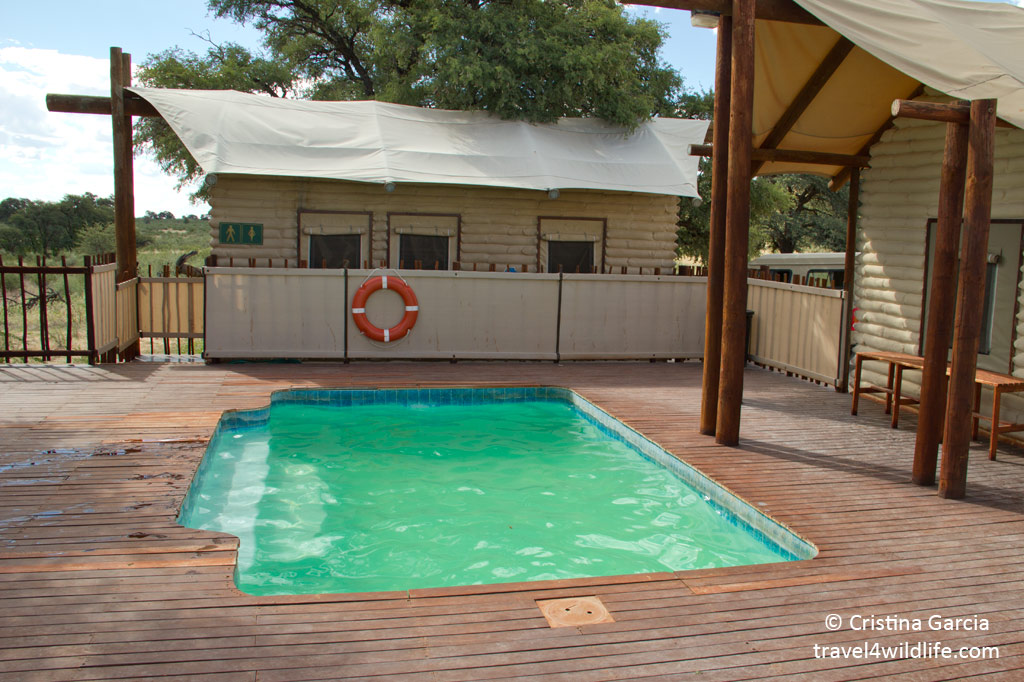
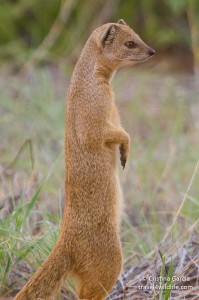
Cristina Garcia
Tuesday 5th of March 2013
We might go back at the end of the year Jessie! I can't wait!
Jennifer
Friday 22nd of February 2013
Such a magical experience. I loved reading this post. The only cheetahs I've seen "in real life" were on TV or in a zoo. Congratulations on being able to partake in a true Africa travel experience.
Cristina Garcia
Friday 22nd of February 2013
Thanks Jennifer. The Kalahari is like our second home. The place where we will always return to.
Barbara Weibel
Monday 18th of February 2013
This looks like a serene and relaxing place. I especially liked the time-lapse view of the Milky Way!
Cristina Garcia
Monday 18th of February 2013
We love that place. The sky in the Kalahari is stunning!